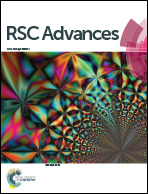Enhanced nutrient removal from lake water via biodegradation of poly(l-lactide)/poly(3-hydroxybutyrate-co-4-hydroxybutyrate) blends
Abstract
Shaped insoluble PLA/P(3HB-co-4HB) blends were applied as slow-release carbon sources to promote the removal of nutrients and facilitate the control of eutrophication in lake water. Various weight ratios of PLA/P(3HB-co-4HB) blends were prepared by electrospinning and melt compounding processes and were added to static aerated lake water. The properties of the blends and nutrient removal from lake water were characterized. The results demonstrated that nutrient removal was enhanced by degradation of PLA/P(3HB-co-4HB) blends, and the consumption of degradation products further promoted the degradation of blends. The orthophosphate concentrations of water samples with electrospun and melt compounded blends exhibited decreases of 59.3–86.4% and 77.8–92.6%, respectively, within 12 hours and decreased to approximately zero over time. Ammonium was completely removed within 1.5–6.5 days and 2.5–5.5 days from water samples with electrospun and melt compounded blends, respectively. Inhibition of nitrite accumulation was observed, and the total inorganic nitrogen content decreased by 9.1–49.5% and 19.8–52.9% within 8 days in water samples with electrospun and melt compounded blends, respectively. Thus, PLA/P(3HB-co-4HB) blends are potentially useful as slow-release carbon sources for nutrient removal from lake water. Moreover, Fourier transform infrared spectroscopy (FTIR), wide-range X-ray diffraction (XRD) and scanning electron microscopy (SEM) were used to characterize the degradation of PLA/P(3HB-co-4HB) blends, and the results showed that the degradation of PLA/P(3HB-co-4HB) blends is closely related to the crystallinity, surface morphology and composition of blends. Given the blends' favorable properties and high efficiency of nutrient removal, PLA/P(3HB-co-4HB) blends are potentially useful as slow-release carbon sources for nutrient removal from lake water. Melt compounded blends with 50 wt% PLA are considered to be the optimal choice for this application.


 Please wait while we load your content...
Please wait while we load your content...